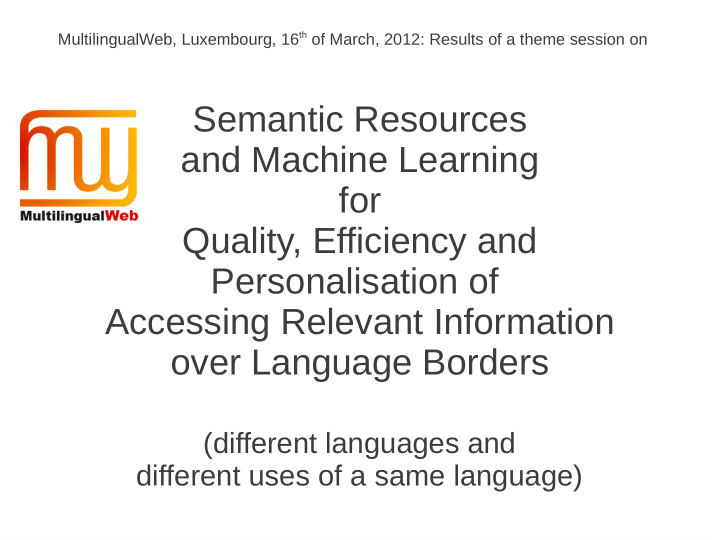



MultilingualWeb, Luxembourg, 16 th of March, 2012: Results of a theme session on Semantic Resources and Machine Learning for Quality, Efficiency and Personalisation of Accessing Relevant Information over Language Borders (different languages and different uses of a same language)
Participants Timo Honkela, Aalto University (rapporteur) ● Peter Schmitz, Publications Office of the EU ● Elena Montanes, Oviedo University ● Tasos Koutoumanos, AgroKnow Tech., Greece ● Corinne Frappart, Publications Office of the EU ● Poul Andersen, WEB translation unit, EU Commission ● Ghassan Haddad, Facebook ● Spyridon Pilos, Language applications, European Commission ● Jose Emilio Labra Gayo, University of Oviedo, Spain ● Maria Pia Montoro, Intrasoft International, Luxembourg ● Daaniel Garcia Magarinos, European Central Bank ●
Quality and consistency versus accessibility and contextual appropriateness of terminology ● Terms good for experts in different domains versus laypersons ● Case: “member state” versus “EU country” ● Case: “human trafficking” versus “modern slavery” ● Case: Bank note security features ● A thesaurus was created as a mapping from technical terms to colloquial language (“iridescent stripe” to “glossy stripe”) ● Case: legislation (Asturias region in Spain): mapping of colloquial terms to official terms, new project: library of congress in Chile
Quality and consistency versus accessibility and contextual appropriateness of terminology ● Convergent and divergent processes in language use ● Ontologies: carefully crafted resources that require considerable resources for implementation and use ● Folksonomies: resources that provide information on the variation and are constructed by the crowds > Possibility to model the crowdsourced data using machine learning techniques
Multilingual contents and thesauri: trust and quality ● Use of EU-generated resources such as ● Eurovoc ● JRC-Names ● Importance of linked open data (LOD) ● Choosing keywords from a controlled vocabulary ● Connecting different term versions with an ontology (or folksonomy) ● Determining a proper contexts using LOD ● Multilingual content: provenance of data ● Quality assurance of LOD
Effect of context in translation: need for context-rich representations ● Often the variation in translation of terminology stems from contextual factors ● It would be important to store enough contextual information in order to facilitate appropriate choices
Social and cognitive levels of language use ● Push and pull of terminology ● Regulation and market economy of language ● Different levels of expertise ● Experts in different domains versus laypersons ● Take home messages: ● Variation among language in conceptual structures (challenges for ontology translation) ● Semantic variation among languge users
Space under Construction Language-Specific Spatial Categorization In First Language Acquisition Melissa Bowerman Max Planck Institute for Psycholinguistics Lund University Cognitive Science 2003
DUTCH OP AAN IN OP AAN IN
Categorization of `opening’ in English and Korean . TTUT YEL TA A 'remove barrier 'tear away PELLITA to interior space' from base' 'separate two parts symmetrically' open take off spread wallpaper open box legs apart open door open unwrap open clamshell mouth open bag package envelope open pair of shutters OPEN open latched eyes open take off drawer open hand ring sun rises open book take cassette open TTUTA out of case fan ‘rise’ spread blanket out PPAYTA peacock spreads tail ‘unfit’ PHYELCHITA 'spread out flat thing'
(Pye 1995, 1996) PLATE STICK ROPE CLOTHES ENGLISH break break break tear, rip duàn MANDARIN può può può (long rigid thing) K’ICHE’ -paxi:j -tóqopi’j -q’upi:j rach’aqij MAYAN (rock, glass, (long, flexible (other hard (“tear”) clay thing) thing) thing) http://www.mpi.nl/people/bowerman-melissa http://www.mpi.nl/people/bowerman-melissa/publications
User-specific difficulty measure Paukkeri, Ollikainen & Honkela, submitted
GICA analysis: Word 'health' in State of the Union Addresses GICA: Grounded Intersubjectivity Concept Analysis Timo Honkela, Juha Raitio, Krista Lagus, Ilari T. Nieminen, Nina Honkela, and Mika Pantzar. Subjects, objects and contexts: Using GICA method to quantify epistemological subjectivity . In Proceedings of IJCNN 2012, International Join Conference on Neural Networks, to appear.
Core of GICA: Subject-Object-Context Tensors Timo Honkela, Nina Janasik, Krista Lagus, Tiina Lindh-Knuutila, Mika Pantzar, and Juha Raitio. GICA: Grounded intersubjective concept analysis - a method for enhancing mutual understanding and participation. Technical Report TKK-ICS-R41, AALTO-ICS, ESPOO, December 2010. http://users.ics.tkk.fi/tho/info/TKK-ICS-R41.shtml http://users.ics.tkk.fi/tho/publications.shtml
Guidelines are needed on how to publish data in multiple languages ● Different versions in different languages ● Alternative language versions ● A standard way of describing how how different versions are related to each other ● Case FAO: Translations should refer back to the original documents
WEB
Linport has related objectives
Recommend
More recommend